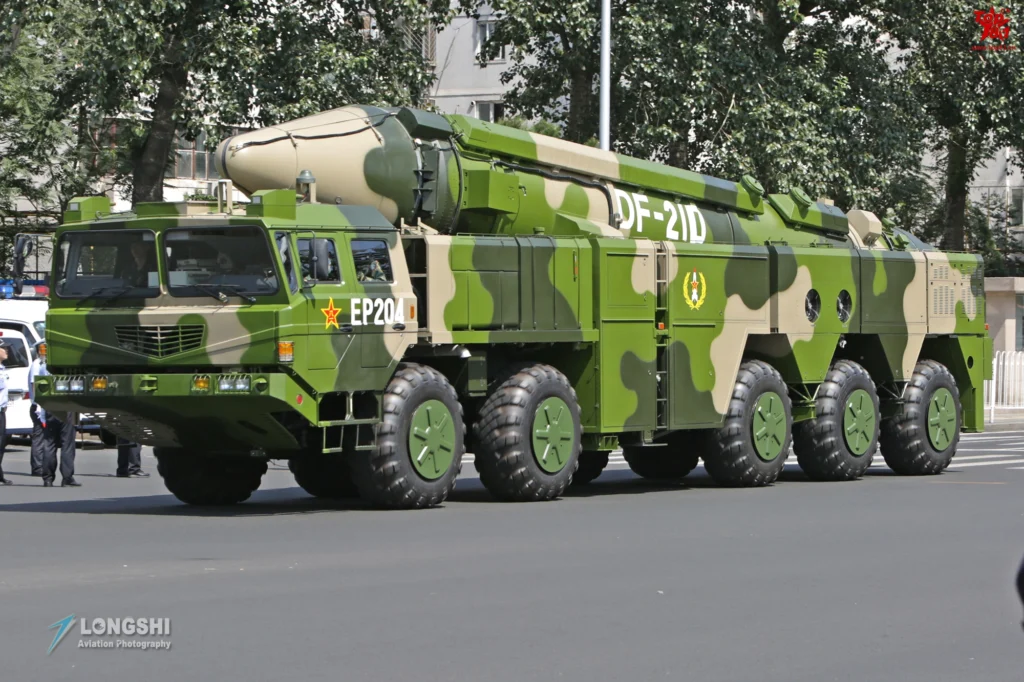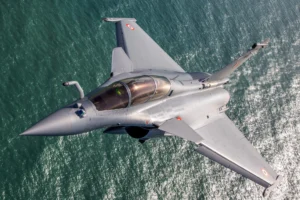Source : The EurAsian Times

The Pentagon acknowledged the threat posed by DF-21s in last year’s annual report on Chinese military might, cautioning that China now has “the capability to conduct long-range precision strikes against ships, including aircraft carriers, out to the Western Pacific from mainland China.”
However, senior US Navy officer, Rear Adm. Carlos Sardiello, commander of the USS Carl Vinson strike group, begged to differ when questioned about Beijing’s “carrier killer” missiles making US carriers less relevant and more vulnerable in a battle in the Western Pacific.
“Our highly trained sailors can operate these complex, contested domains and be lethal and survivable and execute the mission regardless of what the threat is,” he said while speaking to reporters aboard the Carl Vinson carrier, which was deployed to the South China Sea in the Indo Pacific late last year.
Sardiello declared, “I am absolutely confident that the carrier strike group can execute the mission that it was designed to do effectively and safely,” even in the face of Chinese missiles. He went on to say that the strike group “demonstrates the military might of the nation.”
The assertion is significant given that several US military officials and commentators have consistently warned that China’s DF-21 missiles pose a massive threat to US vessels, especially to the American aircraft carrier, which is a projection of its naval might across the world.
The United States recently took a decisive step to strengthen its strategic positioning in the western Pacific by deploying three carriers despite a more precarious situation in the Middle East. These include the USS Carl Vinson, the USS Theodore Roosevelt, and the USS Ronald Reagan.
With a destroyer, cruiser, and submarine, an aircraft carrier can conduct air defense, information gathering, anti-submarine warfare, and other missions as part of a battle group. However, these carrier groups may also be at risk of being struck by a long-range Chinese carrier-killer missile in case of escalation or if a conflict breaks out.
According to the Pentagon, the DF-21, a carrier killer, is equipped with a maneuverable reentry vehicle (MaRV) and has a range exceeding 1,500 kilometers.
Since it uses a solid propellant and a Transporter-Erector-Launcher (TEL) vehicle launch mechanism, the DF-21 has a quick launch time and is portable. This enhances its tactical efficacy by enabling it to be deployed in a military environment that is constantly changing.
Beijing has created several DF-21 variations, including the dual nuclear/conventional capable version (DF-21C) and the anti-ship ballistic missile-designed version (DF-21D). The US Department of Defense (DoD) disclosed in 2016 that Beijing was also considering developing a new nuclear variant (DF-21E CSS-5 Mod 6).
The DF-21 can prevent a possible adversary from entering a combat zone in waterways that Beijing aspires to control, such as the East or South China Seas. This may become a problem given that China has vowed to occupy Taiwan, which Bejing considers a renegade Chinese province.
When an F/A-18 and F-35C are launched from a carrier air wing of a US aircraft carrier, they can travel up to 500 miles, or the most significant distance their combat radius permits.
Thus, a US Navy carrier would have to operate more than 1,000 miles offshore to avoid being put at risk of destruction by a DF-21D. Fighter jets taking off from carriers may not be able to reach this range; therefore, “access” to waters near enough to target China would virtually be denied.
More importantly, the DF-21 could be combined with over-the-horizon radars, maritime intelligence capabilities, and China’s satellite-based marine reconnaissance-strike network. The DF-21D is an essential and symbolic part of the anti-access effort in this sense and is believed to be instrumental for the PLA Navy in a cross-strait conflict.
China seems confident about its anti-carrier capabilities despite the expanding US naval presence in its neighborhood. For instance, when USS Carl Vinson began military drills within the Philippine Sea alongside the USS Theodore Roosevelt and the Japanese helicopter destroyer JS Ise last week, the Chinese state media said that the country remains in possession of anti-ship ballistic missiles, such as the DF-21D and DF-26, designated as potential threats to aircraft carriers.
At the time, Rear Adm. Carlos Sardiello affirmed the readiness of the carrier strike group to execute a comprehensive range of operations. His latest comments about the US aircraft carriers may inspire confidence.
However, there is an overwhelming belief that China’s inventory of long-range anti-ship missiles poses a massive threat to the US carrier operations in the western Pacific region. Additionally, the officer did not quite back his comments with sustainable arguments.
Moreover, across the spectrum, several experts have only highlighted the vulnerability of an aircraft carrier stationed in the Western Pacific due to China’s expanding arsenal of long-range missiles, including the DF-21 and DF-26.

Threat Posed By China’s Anti-Ship Missiles
Experts contend that even as the US military’s carrier deployment helps convey the image that it is prepared to confront North Korea and China if hostilities break out, Beijing’s missile attacks might endanger the US naval fleet. China’s DF-21 anti-ship missiles aim to keep US carriers from getting too close to the western Pacific front.
“In times of war, Chinese rocket forces might try to sink the carriers” that operate within the so-called second island chain, according to Patrick Cronin, chair for Asia-Pacific security at the conservative think tank Hudson Institute. The second chain consists of the islands of Japan stretching to Guam and the islands of Micronesia.
Talking about China’s anti-ship capabilities, with an emphasis on DF-21D missiles, US Navy’s former Indo-Pacific Command Chief (INDOPACOM), Admiral Harry Harris, said in 2021 that “These mid-range, anti-ship ballistic missiles are capable of attacking aircraft carriers in the western Pacific.”
A Congressional Research Service (CRS) report on China’s naval capabilities published in 2022 further contended that China’s stockpile of anti-ship ballistic missiles (ASBMs) can strike moving targets and would essentially block the American Navy from accessing an area a thousand miles off China’s coast.
The report recalled that “a December 3, 2020, press report stated that Admiral Philip Davidson, the commander of US Indo-Pacific Command, confirmed, for the first time from the US government side, that China’s People’s Liberation Army has successfully tested an anti-ship ballistic missile against a moving ship.”
The CRS report warned, “China’s navy is viewed as posing a major challenge to the US Navy’s ability to achieve and maintain wartime control of blue-water ocean areas in the Western Pacific—the first such challenge the US Navy has faced since the end of the Cold War.”
Despite the capabilities that the US Navy already has and is in the process of building, important Japanese ports, like Sasebo and Yokosuka, are home to American warships and could “potentially come under severe attack,” Toshi Yoshihara, a senior scholar at the Center for Strategic and Budgetary Assessment in Washington told Nikkei Asia.
However, the US is not entirely at a disadvantage. Independent US-based defense analyst Ben Lewis previously told EurAsian Times, “DF-21D is something the US military “definitely takes seriously,” and the “defensive capabilities” of the American CSGs are also as credible as the Chinese missile.

“We have the world’s most sophisticated layered air defense protecting our carriers. We have a lot of logistical challenges, but we are making strides in setting ourselves up for easier sustainment of forces in the region.
“While it provides some challenges, I don’t think it eliminates our significant qualitative advantages over the PLA. We have been doing power projection for a very long time, and this experience (combined with the quality of our systems) gives us a serious advantage,” Lewis said.
China’s increased anti-ship capability does not imply that aircraft carriers are obsolete; they continue to play a crucial role in the battlefield, which is why China is developing its third aircraft carrier for its own Navy. The Fujian carrier would most likely be deployed in a cross-strait contingency and is expected to become operational soon.
Moreover, the US Navy may have chosen to prioritize ballistic-missile-intercepting air defense ships, such as the Arleigh Burke Flight III, above platforms like the DDG-1000 and Littoral Combat Ship due to worries about the threat posed by DF-21D.
The United States is also working on the use of hypersonic assault vehicles and cruise missiles launched by SSGNs, which would strike Chinese targets ahead of the Second Artillery’s missile launch. A hypersonic missile is also slated to be installed on the Zumwalt-class warships of the US Navy.
US Navy officials have also clarified that they will operate carriers wherever necessary to project power, even in the face of the DF-21D, which the PLA has continuously test-fired. The deployment of three of its carriers in the Indo-Pacific could testify to Washington’s conviction.
- Contact the author at sakshi.tiwari9555 (at) gmail.com







